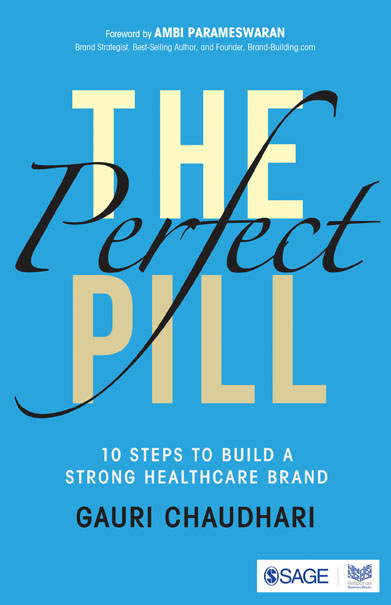Live Encounters Magazine Volume Two December 2020
Gauri Chaudhari is a brand coach, brand strategist and co-founder of Brand Innerword, a health care brand consultancy. In a career spanning 25+ years, she has handled assignments in health care brand building, marketing and advertising. In the past, Gauri has worked in marketing teams of Boehringer Mannheim and Knoll Pharmaceuticals and has handled brands from multiple portfolios.
The Perfect Pill: 10 Steps to Build a Strong Healthcare Brand
by Gauri Chaudhari – Co-Founder Innerworld, Healthcare Brand Consultancy. Published by SAGE – https://stealadeal.sagepub.in/the-perfect-pill-gauri-chaudhari-9789353882518.html
 The Perfect Pill to Build a Brand
The Perfect Pill to Build a Brand
30th March 2020 was the day filled with confusion. My entire family was with me, yet it was not vacation time. With a laptop at the kitchen desk and air pods in ears, my hands were cutting vegetables. While adding tomatoes to the curry, I instructed my clients to change the media plan. The domestic help was obviously not available, and while the work was distributed amongst the other family members, the cooking department naturally had come to me. When I finished the client call, I realized there were eight missed called from an unknown number. What happened? Who is calling me so desperately? The call was from the bank.
Realizing that the bank had nothing specific to pandemic driven life issues, I advised them to send me an email instead of calling. The next day I found a mail from the bank in my email box. With hundreds of emails waiting for a click, I ignored the bank’s email. Just in a couple of days, I received a Whatsapp message, again from the same bank. The message was about the online services, some fixed deposit rates and mutual fund updates. I quickly deleted the message and blocked the messenger. Soon I started seeing the ads of the same across the digital platforms I was visiting. I wondered how much money, time and efforts they might have spent on reaching out to me. I often hear the entire corporate world discussing about digitization, digitalization and digital transformation, but I wonder do they really understand the customer context?
What is the customer value that the brand is providing? How are you adapting the brand and the value that it provides in the given context? How is the value provided by the brand can reduce the current pain points? Only then should they work on the medium, be it digital, physical or virtual.
Brand Building is a systematic process that needs to be followed step by step. There are no shortcuts here. And building customer value is central to this process. My book, The Perfect Pill: 10 Steps to Build a Strong Healthcare Brand, precisely lays out these steps. Though the book is written keeping the healthcare brands at the center, the process elaborated in the book can be adopted by a brand irrespective of its industry. The ten steps explained in the book need to be followed one after the other.
Though one has to read the book to understand these steps and their sequence, I mention a few here to get an idea.
# First thing first
Customers always come first. How cliched !!!! But this is the most important step which companies often forget. Brands exist because the customers do and not vice versa. In a rush to meet the monthly sales targets, companies fail to understand the customer. (Yes, and must mention here, that finally, I did reach to the relationship manager mentioned above. When I told him that he was actually troubling me by calling / messaging, he said, “What to do, ma’am? We have been instructed to call a certain number of customers each day. That is part of my monthly KRA.”)
Understanding your customers is a skill that can be learned. It does way beyond interviewing them or listening to them. It is like getting under their skin. The companies that understand this create products, services and messages that are welcome by the customers.
While every other company was struggling to achieve its sales numbers, Amul grew by 17 percent. Not a mean task. The company tripled its new product launches, which are welcomed by Indian households. How could they do that? They have the pulse of their customers. Even when the customers didn’t know how they may react to a pandemic, Amul could easily gauge.
A good marketer knows what his or her customer says, does, thinks and feels. At times all the four aspects of customers’ life might be contrary to each other, but a marketer sees a thread running through it. That helps them to get into the shoes of the customers and predict their behavior.
At this stage, the need is to put all the information concerning customer’s needs, wants and pain points together here in one basket.
# Next Comes the Brand
What is the big point in understanding the customer, her context but have no solution for her? The next important step is to analyze how can you solve your customer’s problem through your product and service? Where exactly is the fitment? Can you modify the offering? Can you deliver on that offering?
This step has to be done dispassionately. A lot of emotions and pride runs across the corporate ladder when it comes to brands. Need is to see your brands from the eyes of the customers. When Reckitt Benckiser’s Dettol launches surface sanitizer, customers trust it. Will customers trust Colin’s surface sanitizer launched by the same company?
Brand need not solve every problem through its product offering. Many product-driven brands offered services to make their brands more relevant in the given context. USV, a company that does not have any particular COVID 19 treatment product, launched a helpline for patients who wanted guidance. Lupin, another pharma company, launched a service to help patients with mental issues in the pandemic. The idea is to be relevant and partner with customers even if you don’t have a product offering in that direction.
So, fill up the second basket of information that lists the current and potential benefits of the product/ services that you offer.
# Coming to the Competition
How is competition helping customers? What are they good at? This is yet another important question. Copying the competition is a crime for which every marketer gets punished. Having understood customers, mapped your offering as per the customer requirement, next is to look for differentiation. Customers reward companies for their valuable differentiation.
It is often an interesting note that every other brand in the market may not be your competition. Some brands from your own category might be brand best companions. In the world of pharma and healthcare, there are many brands from the same category get co-prescribed.
Having decided on the right competition need is to put in all the differentiating points your brand has over the competitor’s and put it together in another basket called competition basket.
# Arriving at the key proposition
When all the three baskets of information are filled, arriving at the proposition is not difficult. Just put all the three baskets together and look at the cross-section.
To get more clarity on the brand value, you may ask a simple question, “In a given situation, what is it that my customers want, my brand can honestly offer, but my competition can’t.”
Believe me; this simple question provides multiple profound answers. All those answers provide that value proposition to which customers get naturally attracted.
In my experience, this exercise brings out several value propositions, even from the most ordinary undifferentiated brand.
From this bundle of values, brand teams need to filter down one key value that is most relevant to the customers.
Once arrived at the most attractive value proposition, the book elaborates on several other steps that are critical in further building and communicating that value.
The last chapter in the book is about Media planning. It elaborates various ways a healthcare brand may adapt to reach out to the masses, digital being one of them.
Finally, the book warns its readers not to jump the steps. By quickly rushing to the last step of working on a media plan tantamount to putting the cart before the horse and wondering why the cart is not moving.
© Gauri Chaudhuri



 The Perfect Pill to Build a Brand
The Perfect Pill to Build a Brand